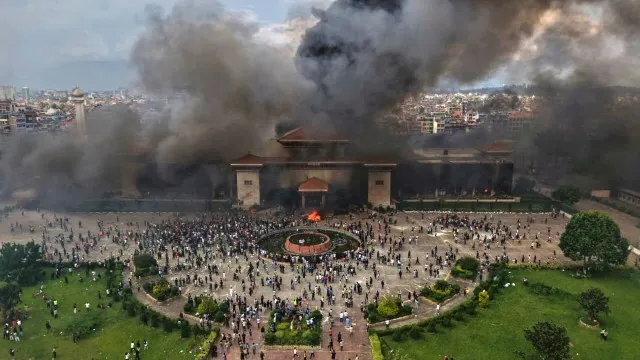Nepal is the latest victim of a romanticized Western media script -- the tale of a student-led "revolution" toppling a supposedly corrupt, inefficient government in a developing country.
The same script sanctified the August 2024 ouster of "iron lady" Sheikh Hasina in Bangladesh, which has since descended into intensifying repression and Islamist violence. Indonesia's weeks-long unrest may yet be packaged as another "people's revolution," should its government fall.
This oversimplified narrative conceals the real drivers of upheaval -- factional power struggles, economic stress and cynical opportunism -- while implicitly condoning violence, including the torching of state institutions. Such acts would attract long prison terms in the West, but abroad, they are framed in terms of democratic romance. For Western audiences, it is spectacle; for the countries involved, it often entails extended disorder.
In Nepal, former Chief Justice Sushila Karki was rebranded by Western media outlets as an "anti-corruption crusader." In reality, Karki -- the wife of the mastermind behind the 1973 hijacking of a Nepalese airliner carrying millions of Indian rupees -- now heads an interim administration with no constitutional legitimacy and little more than rubble to govern.
Nepal's so-called revolution has left nearly every important state institution in ruins. Parliament, the supreme court and most government offices were burned in a coordinated arson spree, with files and records reduced to ashes. Thousands of buildings across the Himalayan nation of 30 million -- from state banks and luxury hotels to supermarkets and homes of politicians and businessmen -- were looted and torched. In the capital Kathmandu alone, the damage runs into billions of dollars. Even police officers were not spared: At least three were seized and lynched by mobs.
This was not democracy in action but nihilistic violence dressed up as revolution. As one prominent social activist told protesters while aiding burn victims, "You burned this country down." Amid the wreckage, simply restoring day-to-day governance will be an immense struggle.
The spark had been a government ban on 26 social media platforms -- from X and Facebook to WhatsApp -- for failing to register under new regulations. In a country where a lack of jobs has forced at least 7.5 percent of the population to work abroad, such platforms are vital lifelines for families dependent on foreign remittances, which made up 33 percent of Nepal's GDP in 2024. The ban abruptly disrupted communication, igniting public anger.
On Sept. 9, the protests began peacefully, with mostly youths and some students participating. But by evening, after police had fatally shot several rioters, the mood changed. With no leadership to channel the unrest, chaos exploded the next day.
Mobs armed with jerrycans of gasoline targeted symbols of state authority. Others looted and burned businesses and private homes. Still others raided government armories, arming themselves with rifles and grenades.
Yet in the media narrative, the upheaval morphed into a "student-led" anti-graft movement against a corrupt elite. The actual trigger -- the social media ban -- was largely overlooked. To describe this mayhem as "people power" is to confuse anarchy with democracy.
The fury on the streets did topple the elected coalition government of Prime Minister K.P. Sharma Oli, a Marxist. But the illusion of democratic awakening masks the reality of chronic instability since Nepal became a federal democratic republic in 2008. In the last 17 years alone, the country has cycled through 15 governments, with Karki now presiding over the latest.
The consequences are dire. Institutions have been gutted, the constitutional order suspended and society fractured. An unelected interim government cannot restore trust, much less stability, which explains why Karki has scheduled new elections for March 5.
For India, turmoil next door is more than an academic concern. The two countries share an open border of over a thousand miles, permitting free movement of people without passports. Instability in Nepal invariably seeps across the frontier -- in the form of refugees, smuggling or insurgent spillovers.
This is hardly the first time Western analysts have mistaken mob rule for popular empowerment. As history shows, when mobs overthrow governments, the winners are not "the people" but the men in uniform. After sliding into chaos and anarchy, Nepal effectively came under army control, raising troubling questions about its future military-civilian balance.
The West's romanticization of uprisings in fragile states is dangerous. By valorizing mob violence as a form of democratic ferment, it lends legitimacy to movements that destroy institutions rather than strengthen them. It blinds outsiders to the fact that the real victors are often military generals, not citizens. And it reduces the genuine struggle for accountable governance to a spectacle for foreign consumption.
Western media, which double as international media, usually apply one standard at home and another abroad. When a mob stormed the U.S. Capitol on Jan. 6, 2021, it was rightly condemned as lawlessness and an assault on democracy. Yet when rioters in Nepal lynch police and torch government institutions, it is hailed as a "people's revolution."
Such double standards do more than mislead -- they dignify disorder elsewhere that would never be tolerated at home.
Nepal's tragedy should serve as a cautionary tale. Democracy cannot be built on ashes and lynchings. It rests on institutions, legality and order -- the very foundations mobs destroyed and the military has now sought to restore. To mistake chaos for change is to invite more instability, not less.
Brahma Chellaney is a geostrategist and the author of nine books, including the award-winning "Water: Asia's New Battleground."
